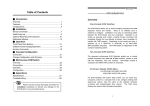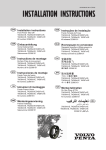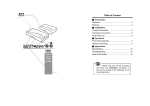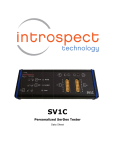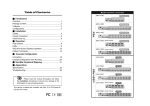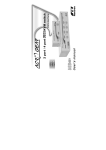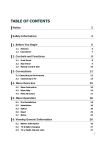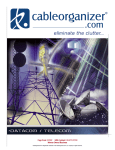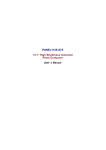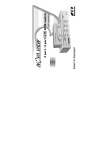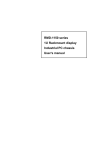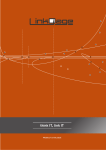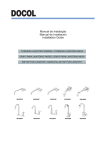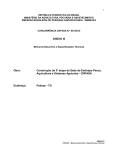Download Product Manual
Transcript
Table of Contents
! " Introduction
Overview……………………………………..………….…………1
Features………………………………………..….…………….…3
Configurations………………….………………..………………...4
! " Installation
Device Connection…………………..…………..………….…….7
Initial Power-up…………………..………………..….……….…..9
Optional Rack Mount Accessories…………….…………..…..10
Multimedia Module…………….………………………………...12
! " Operation
Front Panel Push Buttons………….…………………..……....13
OSD(On-Screen Display)Operation………….……………......14
Hot-key Commands…………………………..………...............20
! " Cascade Configuration
Connection………….…………………………..………....….....22
Change Configuration while Running………..……….....…….24
! " Multi-access NovaView
Overview…………......…………………………………...……...25
Connections……......…………………………………………….25
Operation……......…………………………………………….....26
Configuration……......……………….…………………………..26
! " Appendices
Specifications……......…………………………………….........27
Troubleshooting……......………………………………………..28!
!
!
!
!
Please read this manual thoroughly and f ollow the
Installation procedures to prev ent any damage to the
Nov aView or any connecting dev ice. !
!
!
!
""""""""""""""""""""""""!#$%&'()*%+ '$!
Overview
One-Console NovaView Switches
The Nov aView allows you to access multiple computers from one
key board, mouse and monitor. There is no interface card or
sof tware to conf igure. Installation is as easy as connecting cables
between the NovaView and y our computers. Operation is as simple
as pressing push button, entering hot-key command and navigating
through the user-friendly on-screen menu (available on models with
OSD support). Depending on the model y ou have, it switches up to
4 (KNV104), 8 (KNV108) or 16 (KNV116) IBM-compatible computers.
The Nov aView is independent of the computer operating sy stem.
Two-Console NovaView Switches
The adv anced multi-access NovaView Switches enable you to control
multiple computers f rom two different locations, remote and local with
two keyboards, mice and monitors.
KNV2108D controls 8
computers and KNV2116D controls 16 computers.
On-Screen Display (OSD) Menu
For KNV104D, KNV108D, KNV116D
KNV2108D, KNV2116D models
For Nov aViews with built-in OSD control, you can name y our
computers, switch to a computer from a list, conf igure settings with
easy -to-use menus, view the name of the selected computer
on-screen with programmable time interv al. The OSD displays the
sy stem status throughout operation.
!
!
!
!
!
"!
!
!
Features
Automatic Mouse Conversion
!Supports both PS/2 and serial mouse
!Cascade conf iguration expands sy stem capability
!Auto-scan automatically selects computers sequentially
!Supports Microsof t IntelliMouse (Pro)
!Hot-key f unctions allow easy computer access
!Key board states automatically sav ed and restored when switching
computers
!Operating sy stem independent, transparent to all applications
!Plug and play sy stem conf iguration
!Key board and mouse can be hot plugged at any time
!High VGA resolution 1920 x 1440
!DDC2B compatible
!Optional standard 19 inch rack mounting kit av ailable
!Supports optional multimedia module f or microphones and stereo
speakers
The Nov aView Switch enable you to connect computers with PS/2 or
serial mouse ports (using adapters supplied with each Nov aView
Switch) and control the computers from one PS/2 mouse. The
Nov aView automatically identifies the mouse and switches to proper
mouse protocol.
!
High Video Quality
Nov aView supports VGA resolution up to 1920 x 1440 without any
degradation. Adv anced VGA circuit design guarantees smooth and
flicker-f ree switching f rom one computer to the other with distance up
to 100f t (30M)* at both Console and PC sides.
NOTE: This User's Manual is written for the following models.
Extra features for On-Screen Display model
NovaView Switch Models
No. of console
supported
1
1
1
2
2
No. of PC supported
No OSD
4
8
16
8
16
OSD
!Assign computers with unique and meaningf ul names
!Identif y and select computers by the names
!Programmable scan f ilters unused computers
!Store sy stem settings and name entries to non-v olatile memory
!Password security locks computer f rom unauthorized access
!Gain complete control with easy -to-use OSD interf ace
!"#$%&' !"#$%('
)'
)'
)'
!"#$%&*' !"#$%(*' !"#$$+*' !"#,$%(*' !"#,$$+*'
More features for multi-access models
!Manage multiple computers f rom two locations
!Dif f erent Console may hav e dif f erent ty pe of mouse i.e. generic
PS/2 mouse and scroll mouse
!Selectable User Timeout
* Tested with high-quality UL2919-rated, low-loss and shielded cables.
!
#!
!
$!
!
!
Configurations
Cascade (Master/Slave) Configuration
Nov aView has sev eral models each supporting a different number of
computers. For applications with a large number of computers,
Nov aViews can be cascaded in a master/slave configuration to
support ev en more computers.
Single NovaView Configuration
Connect a PS/2 key board, a PS/2 mouse and a VGA multi-sy nc
monitor directly to the Master’s CONSOLE port. Then, connect
multiple sets of keyboard, mouse and monitor cables to the “PC x”
ports of the Nov aView, as shown in f igure 1.
You can connect a second level of one or more Nov aViews to “PC
1”~”PC 4” (KNV104) or "PC 1"~”PC 8” ports (KNV108 & KNV116) of
a Master unit. Cascade configuration expands system ability
allowing y ou to select computers connected to the Master or Slaves.
There is only one Master, which has a mouse, a keyboard and a
monitor connected to its CONSOLE port directly operated by a user.
Once connected, Nov aViews automatically conf igure themselv es to
either Master or Slave. Slaves of different NovaView models can be
mixed in cascade configuration. [NOTE: Master must have equal or
more PC ports than that of Slaves, i.e., if KNV108 is a master,
KNV108 and KNV104 can be Slaves, but KNV116 can not.]
Figure 1: A single NovaView configuration
Figure 2: A cascade NovaView configuration
Throughout this manual, Master is the NovaView that has a phy sical
key board, mouse and monitor connected to its CONSOLE port.
Slave is a Nov aView that has its CONSOLE port connected to a
Master's “PC x” port. Slave only exists in cascade conf iguration.
!
%!
!
&!
!
!
" " " " " " " " " " " " " " " " " " " " " " " " ! # $ , % - ..- % + ' $ !
Device Connection
The monitor connected to the HD-DB-15 VGA port of a Master
CONSOLE must be capable of sy nchronizing with the computer's
video signal. If y ou are uncertain about the monitor ty pe, please
consult the monitor user's manual. Connect a PS/2 mouse and a
key board to the CONSOLE port marked with a mouse and a
key board respectively as shown in f igure 3. [NOTE: Only a PS/2
mouse can be connected to the CONSOLE mouse port. The
NovaView's automatic mouse conversion system allows you to
connect computers using serial mouse and control the computers
from one PS/2 mouse.]
Figure 3: Master console connection
!
'!
!
(!
!
!
Determine the channel address of each computer. For computers
using PS/2 mouse, connect the computer's mouse and key board
cables to the Nov aView’s connectors marked with a mouse and
key board respectiv ely, as shown in f igure 4.
Initial Power-Up
Make sure all computers and NovaViews are powered down
during installation. You must power up the Master NovaView
before turning on any other devices.
! For single NovaView: 1) Apply a power adapter to the Master.
2) Turn on computers.
! For cascade: 1) Apply a power adapter to the Master.
2) Apply power adapters to all Slaves.
3) Turn on
computers.
Note: You may hot plug additional powered-down computer and
Slave without turning any existing Nov aView or computer off after
initial power up.
Replace Master Console Devices
Figure 4: Master computer connection
For computers using serial mouse, connect the DB-9 to mini-DIN-6
adapter (supplied with the NovaView) to the computer mouse port,
then use PS/2 cables to connect the mouse to NovaView, see f igure
5. Connect the computer's monitor cable to the HD-DB-15 VGA
connector. Repeat above steps for all remaining computers to be
connected to the Nov aView.
You can replace a faulty key board or mouse of the Master
CONSOLE port at any time without powering down the Master, as
long as y our computers are booted with proper dev ice driver for the
new dev ice. Should y ou encounter any difficulty, just activ ate K/M
RESET by holding both f ront-panel ‘1’ and ‘2’ push buttons down f or
2 seconds.
Adhesive Rubber Foot
For desk-top operation, y ou may stick the f our round rubber feet
(supplied with the unit) to the bottom of the Nov aView. NOTE: Do
not use the rubber f eet f or rack mount operation.
Figure 5: Adapter and serial mouse connection
!
)!
!
*!
!
!
Optional Rack Mount Accessories
Figure 7 shows how to assemble rack cable support then screw it to
the back and inside the rack cabinet v ertical post.
Figure 6 shows how to attach optional mounting brackets to the
Nov aView unit f or standard 19-inch rack cabinet.
Figure 6: Attaching rack mount bracket
Figure 7: Assembling rack cable support
Then, keyboard/mouse/monitor cables can be routed over the cable
support. You can use plastic cable ties to bundle and label the
cables through the rack cable support holes f or easy identif ication.
!
"+!
!
""
!
!
Multimedia Module
!
""""""""""""""""""""""""!/ 01&-%+ '$
An optional multimedia A/V module (MAV108) is used to select
microphone, speaker and monitor signals f rom one out of eight
computers. The A/V module is connected to the LINK port on the
rear panel v ia an mini-DIN-8 connector. When a computer is
selected, the microphone signal is directed to that computer, speaker
and monitor signal source f rom the same computer.
As an OSD option, the A/V module may select a computer different
from that of the Nov aView system. There are two options in Audio
Stick f unction (<F4>:More\Audio Stick). When set to ' On ', A/V
module selection follows computer selection. When set to ' Off', A/V
module selection stops f ollowing computer selection. It is usef ul if
y ou want to listen to one particular computer's audio signal while
selecting other computers during operation.
Front Panel Push Buttons
You may select a computer by pressing the f ront panel push button
directly, by issuing hot-key commands or by activ ating the OSD
window (f or models with OSD support). The f ront panel indicator
changes to ref lect the computer port selected (red) and whether the
port is connected to a powered computer (green). The indicator
f lashes red when it is in either Auto Scan or Manual Scan mode.
Figure 8: Front panel indictor
With extra VGA ports, the A/V module enables you to view multiple
monitors from one PC at the same time. Now you can extend y our
Windows desktop f or all y our computers and switch accordingly.
So me computers support 'keyboard/mouse power up' function, i.e.,
press certain keys or mouse buttons to startup the computers. Their
corresponding green front indicators lit all the time even if the
computers are 'off'.
" K/M RESET
K/M RESET solv es most problems dev eloped by keyboard, mouse,
dev ice replacement or change of conf iguration. Press down both
the front-panel number 1 and 2 push buttons f or 2 seconds to
re-conf igure the whole system without turning either the Nov aView
Switch or any computer of f .
" AUTO SCAN
Nov aView prov ides an easy to use f eature to start Auto Scanning.
You can press down both the front-panel number 7 and 8 buttons f or
2 seconds to start Auto Scanning.
!
"#!
!
"$!
!
!
OSD (On-Screen-Display) Operation
The color of a device name is green if it has power and is ready for
operation, or the color is white as it has no power. OSD menu
updates the color when it is activated.
The <PageUp> and
<PageDown> key s can be used to v iew 8 other computers at a time;
not ef f ectiv e f or a 4-port KVM switch.
KNV104D,KNV108D,KNV116D,KNV2108D,KNV2116D
Use the “!“, “"“, “1“ ~ “8“ or “A“ ~ “H“ to highlight a computer and
the <ENTER> key to select it. Or, y ou may press <ESCAPE> to exit
OSD and remove the OSD menu from the display; the status window
returns to the display and indicates the currently selected computer
or operating status. For a 4-port KVM switch, you can only use the
“!“ and “"“ arrow key s to highlight a computer.
A triangle mark (!) to the right of a name indicates the port is
cascaded to a Slave; the number at the left of the triangle mark
shows the number of ports the Slave has, i.e. 8!for an 8-port switch.
<ENTER> key brings y ou one level down and another screen pops
up listing the names of the computers on that Slave. The name of
the Slave will be shown at the upper right corner of the OSD menu.
It is useful to group computers and still be able to see the group
name.
An ey e mark (#) to the right of a name indicating the computer is
selected to be monitored in Scan mode. In OSD, this mark can be
switched on or of f by f unction key <F2>.
Figure 7: OSD screen illustration
Press <ESCAPE> key to exit OSD and to return to the selected
computer; the computer name is also shown on the screen.
By hitting the left <CTRL> key twice within two seconds, you may see
the 'Hotkey Menu ' if it is enabled (an OSD option). Or, by hitting the
left <CTRL> key three times within two seconds, you will see a ' KVM
MENU ' screen showing a list of the computers with corresponding
port numbers, names and status, see figure 7. The OSD menu of a
4-port KVM switch looks slightly dif f erent.
$Function key
<F1>: To edit name entry of a computer or a
Slave with up to 14 characters. For 4-port KVM switches, the
maximum number of character is 8. First, highlight a port then
press <F1> f ollowed by name entry. Valid characters are ‘A’~’Z’,
‘0’~’9’ and the dash character. Lowercase letters are converted
to uppercase ones. Press <BACKSPACE> to delete a letter
one at a time. Non-v olatile memory stores all name entries until
y ou change, ev en if the unit is powered down.
The port number of the currently selected computer is displayed in
red, same as the f ront indicator, at the right corner of the OSD menu.
!
"%!
!
"&!
!
!
$Function
key <F2>: To switch
computer on or off. First, use the
key s to highlight it, then press <F2>
of f . If Scan Type is ' Ready PC
the eye mark (#) of a
<UP> and <DOWN> arrow
to switch its eye mark on or
+#', only the power-on and
described below. Most of them are marked with a triangle (!)
indicating there are options to choose f rom. Using the <UP>
and <DOWN> arrow keys, select the functions and press
<ENTER>. Av ailable options will be shown in the middle of the
screen. Again, using the <UP> and <DOWN> arrow keys to
view options then press <ENTER> to select it. You can press
<ESCAPE> to exit at any time.
ey e mark selected computers will be display ed sequentially in
Scan mode.
$Function
access.
key <F3>: To lock a computer f rom unauthorized
To lock a dev ice, highlight it then press <F3>. Now,
!"Auto Scan
In this mode, the Integra automatically switches f rom one
power-on computer to the next sequentially in a fixed
interv al. During Auto Scan mode, the OSD displays the
enter up to 4 characters (‘A’~’Z’, ‘0’~’9, ‘-‘) f ollowed by <ENTER>
as new password. A Security-enabled dev ice is marked with a
lock (%) f ollowing its port number. To permanently disable the
security function f rom a locked dev ice, highlight it, press <F3>
then enter the password. For a 4-port KVM switch, only one port
can be locked by password.
name of the selected computer.
When Auto Scan
detects any key board or mouse activ ity, it suspends the
scanning till activ ity stops; it then resumes with the next
computer in sequence. To abort the Auto Scan mode,
press the left <CTRL> twice, or, press any front button.
Scan Type and Scan Rate set the scan pattern. Scan
If y ou want to access the locked dev ice temporarily, simply
highlight it and press <ENTER>, the OSD will ask y ou for the
password. After entering the correct password, you are allowed
to use the dev ice. This dev ice is automatically re-locked once
y ou switch to another port. During Scan mode, OSD skips the
password-protected dev ices.
Type (<F4>:More\Scan Ty pe) determines if scanned
computers must also be eye mark selected. Scan Rate
(<F4>:More\Scan Rate) sets the display interv al when a
computer is selected bef ore selecting the next one.
If you forget the password, the only way to permanently
erase all the passwords is to:
Press and hold the front panel buttons “1” and “2”, then
hold “7” and “8”. Release “7” and “8”, then release “1”
and “2”.
!"Manual Scan
Scan through power-on computers one by one by
key board control. can Type (<F4>:More\Scan Ty pe)
determines if scanned computers must also be eye mark
selected. Press the up arrow key (# ) to select the
prev ious computer and the down arrow key ($ ) to select
the next computer. Press any other key to abort the
Manual Scan mode.
For 4-port KVM switches: If you forget the password, the only
way to permanently disable the security function is to remove
all possible power sources from the master KVM switch. You
need to turn off all computers and unplug the power adapter,
then restart everything.
!"Audio Stick
An optional multimedia module can be LINKed to the
back of each Integra KVM switch for selecting
microphone and stereo speaker signals. There are two
$Function
<F4>.
!
key <F4>: More functions are available by hitting
A new screen pops up display ing more f unctions as
"'!
!
"(!
!
!
!"CH Display
options f or Audio Stick: ON and Off. When set to ' On',
audio selection f ollows computer selection. When set to
' Off', audio selection stops following computer selection.
It is usef ul if you want to listen to a particular computer's
audio signal while operating other computers. The
non-v olatile memory stores the Audio Stick setting.
Auto Off: After you select a computer, the port number
and name of the computer will appear on the screen for 3
seconds then disappear automatically. Always On: The
port number and name of a selected computer and/or
OSD status display ed on the screen all the time. The
non-v olatile memory stores the CH Display setting.
!"Scan Type
!"Position
Ready PC +# : In Scan mode, scan through power-on
and ey e mark selected computers.
The position of the selected computer name and/or OSD
status display ed on screen during operation. The actual
display position shifts due to different VGA resolution, the
higher the resolution the higher the display position.
The non-v olatile memory stores the Position setting.
Ready PC : In Scan mode, scan through power-on
computers.
# Only: In Scan mode, scan through any # selected
Upper Left
Lower Left
Middle
computer regardless of computer power status. This
option is not av ailable f or 4-port KVM switches.
The non-v olatile memory stores the Scan Type setting.
(UL ), Upper Right
(LL ), Lower Right
(MI ).
$ ESC: To exit the OSD, press the <ESCAPE> key.
!"Scan Rate
Sets the duration of a computer displayed in Auto Scan
mode. The options are 3 seconds, 8 seconds, 15
seconds and 30 seconds. The non-v olatile memory
stores the Scan Rate setting.
!"Keyboard Speed
Integra offers key board ty pematic setting that ov errides
the similar settings in BIOS and in Windows. Av ailable
speed options are Low, Middle, Fast and Faster as 10,
15, 20 and 30 characters/sec respectively. The
non-v olatile memory stores the Key board Speed setting.
!"Hotkey Menu
When y ou hit the left <CTRL> key twice within two
seconds, the "Hotkey Menu" appears displaying a list of
hot-key commands if the option is On . The 'Hotkey Menu'
can be turned Off if y ou prefer not to see it when the left
<CTRL> key is hit twice. The non-v olatile memory stores
the Hotkey Menu setting.
!
(UR ),
(LR ).
")!
!
"*!
!
!
When Auto Scan detects any key board or mouse activity, it
suspends the scanning till activ ity stops; it then resumes with the
next computer in sequence. The length of the Auto Scan interv al
(Scan Rate) is adjustable, see below. To abort the Auto Scan
mode, press the lef t Ctrl key twice.
Note: For OSD models, Scan Type determines whether ey e mark is
necessary during Auto Scan.
Hot-key commands
Hot-key command is a short key board sequence to select a computer,
to activ ate computer scan, etc. NovaView interprets keystrokes f or
hot-keys all the time. A hot-key sequence starts with two left
<CTRL> keystrokes followed by one or two more keystrokes. A
built-in buzzer generates a high-pitch beep for correct hot-key
command; otherwise, one low-pitch beep f or error and the bad key
sequence will not be f orwarded to the selected computer.
The short f orm hot-key menu can be turned on as an OSD f unction
(<F4>:more\Hotkey Menu) ev ery time the left <CTRL> key is pressed
twice.
L-CTRL : is the <CTRL> key located at the left side of the
key board.
1~8/A~H : are the number keys '1' ~ '8' at the upper row of the
key board and character keys 'A' ~ 'H' case
insensitive. Do not use the keypad at the right of
the keyboard.
& To select a computer by hot-key command, y ou must know its
channel address, which is determined by the Nov aView
connection. For a computer connected to a Master, its address
is represented by the PC port label (1~8 or A~H). For a
computer connected to a Slave, two characters represent its
address. The first character is the channel address of the Master
unit (1~8) and the second one is the channel address of the Slave
(1~8 or A~H). Please note that only Master's 'PC 1' ~'PC 8' ports
can be connected to a Slave.
Lef t Ctrl + lef t Ctrl + 7
Selects a computer connected to port 7 of the Master.
Lef t Ctrl + lef t Ctrl + 6 + C
Selects a computer connected to port C of a Slave connected
to port 6 of the Master.
& Manual Scan enables y ou to manually switch back and forth
between power-on computers.
lef t Ctrl + lef t Ctrl + F2
Press # or $ to select the prev ious or the next computer in
sequence. And, press any other key to abort the Manual Scan.
Note: For OSD models, Scan Type determines whether ey e mark is
necessary during Manual Scan.
& To adjust Scan Rate which sets the duration before switching to
the next computer in Auto Scan:
lef t Ctrl + lef t Ctrl + F3
The Nov aView sends one to four beeps indicating scan interv al of 3,
8, 15 and 30 seconds respectiv ely.
& To adjust key board typematic rate (characters/sec), this setting
ov er-rides that of BIOS and any operating sy stem:
lef t Ctrl + lef t Ctrl + F4
The Nov aView generates 1 to 4 beeps corresponding to 10, 15, 20
and 30 characters/sec respectiv ely.
& To start Auto Scan, automatically scan power-on computers one
by one at a f ixed interv al:
lef t Ctrl + lef t Ctrl + F 1
& Audio Stick
An optional multimedia module can be LINKed to the back of each
Nov aView f or selecting microphone and stereo speaker signals.
There are two options f or Audio Stick: ON and Off. When set to
' On ', audio selection follows computer selection. When set to ' Off',
audio selection stops f ollowing computer selection. It is useful if
y ou want to listen to a particular computer's audio signal while
operating other computers.
lef t Ctrl + lef t Ctrl + F5
The Nov aView generates 1 or 2 beeps corresponding to On and Off
respectiv ely.
!
!
#+!
#"!
!
!
!
" " " " " " """"""""" !2-, *-(1!2'$3+4 )&-%+'$
Connection
Before connecting a device (a computer or a Slave) to the Master
under power, you must turn off the device. The Master must have
equal or more 'PC x' ports than that of the Slave, i.e., if KNV108 is
the master, KNV108 and KNV104 can be Slaves, but KNV116 can
not.
The ports labeled "PC 1"~”PC 8” can be connected to either a
computer or a Slave's CONSOLE port, as shown in f igure 10. The
ports “PC A"~”PC H ” can only be connected to a computer. A
power adapter with DC 9V/500mA output rating must be connected
to the Master.
Figure 11: Cascaded 4-port NovaViews
Figure 12: Cascaded 8-port NovaViews
Figure 10: Slave console connection
The maximum number of computers controlled by a master/slav e
conf iguration with all KNV104s is 16 with 4 Slaves and each Slave
connects to 4 computers, see figure 11. For an all KNV108s
conf iguration, the number is 64 with 8 Slaves and each Slave
connects to 8 computers, see f igure 12. For an all KNV116
conf iguration, the number is 136, see figure 13. The Master
KNV116 connects to 8 Slav es and 8 computers, and each Slave
connects to 16 computers.
!
##!
Figure 13: Cascaded 16-port NovaViews
!
#$!
!
!
!
" " " " " " " " " " " " " " " " " " 5).%+"-**1,,!6'7-8+19
KNV2108D & KNV2116D
For OSD model:
After connection completes, you should re-activate
the OSD menu to check if the Master recognizes the
Slaves. A triangle mark (!) is placed to the right
of the channel name indicating the port is connected
to a Slave not a computer. A number to the left of
the triangle mark indicates the Slave model, i.e. 8!
f or KNV108 or KNV108D.
Change Configuration while Running
Dev ices at any ' PC x' port can be changed at any time after initial
power-up. If you change any one of the “PC 1” to “PC 8” ports
connection from a computer to a Slave or v ice versa, or replace the
dev ices of a port; the OSD will update this change the next time it is
activ ated. [NOTE: Any new device, a computer or a Slave, must be
turned off before it is connected to the Master.]
!
#%!
Overview
The adv anced multi-access KNV2108D and KNV2116D hav e all the
f eatures of KNV108D and KNV116D respectively. Both models
hav e two Console ports f acilitate y ou to access multiple computers
from two different locations, local and remote. Thanks to the
high-driv e circuit design, you may connect high quality cables at
Console and PC sides f or up to 100ft (30M), a def inite plus for serv er
room applications. Now you can access all computers either in the
serv er room when y ou hav e to physically access the computers such
as sof tware upgrade, or away f rom the serv er room for everyday use.
Connections
Connect two key boards, mice and monitors to the two CONSOLE
ports. The built-in PS/2 mouse signal translation enables y ou to
connect PS/2 mice of different type to the CONSOLE ports, i.e., a
generic PS/2 mouse f or one CONSOLE and a scroll mouse f or
another.
!
#&!
!
!
!
""""""""""""""""""""""""!:001$(+ *1, !
Operation
On power up, the KNV2108D and KNV2116D are in Idle mode
broadcasting VGA signal from the selected computer and detecting
f or keyboard and mouse activity. User LEDs (marked with reverse
white " and #) are both red indicating the Nov aView is not in use.
Specifications:
Specifications
!"#$%&'
!"#$%('
!"#$%&*'
!"#$%(*'
-./0'1203'4567/0'
!"
!"
826153/0'1203'4567/0'
$"
%"
89.:9;/':24302<'=8'4567/0' '(")*"!&+" '(")*"&$+"
>4).:0//4';?.1<9@'A>B*C' -./!0$1" -./!0%1"
D0243'194/<'753324':24302<'
$"
%"
E23'1<5F)94;)1<9@'
E23)G/@':24302<'
When key board or mouse activ ity is detected at one CONSOLE, the
Nov aView immediately disables the other CONSOLE f rom accessing
the computer. Only one User LED, at the front panel, remains lit
indicating the Nov aView is under user operation. In the mean time,
key board LEDs (Num/Caps/Scroll Lock) of the other CONSOLE start
to f lash as its access is denied and the monitor is blocked f rom VGA
signal for security reason. Af ter the user has finished his operation
f or a period of time (i.e., User Timeout), the multi-access Nov aView
Switch returns to Idle mode. User Timeout has f our options, 5 sec,
30 sec, 60 sec and HOLD. Select HOLD when y ou plan to access
the NovaView f or a long time. Pressing the <Scroll Lock> twice
f orces the NovaView return to Idle mode immediately regardless of
the User Timeout setting.
H9:G)62543'G?3'
I532693?:'.:94'?43/0J9<'
#'!
'
!"
#"
!&"
%"
'(")*"!,&+" '(")*"&$+"
'
#"
!&"
'(")*"!,&+"
234"
!&"
%"
!&"
234"
234"
56-!&"
56-0%"
,7"%7"!87",0"439*:;4"
56-!&"
G/@7290;'
EBJ#" "
824.2</' ' 625./':244/:320'
EBJ#"
624?320'
O1P1IP!8"=3Q?L3"
E'M'O'M'*'A66C'
$$H##0H!,0" $$H$,&H!%0" %%H$,&H##0" $$H$,&H!%0" %%H$,&H##0"
' ' ' ' ' ' ' ' A?4PC'
!RSH%RSH8R!" !RSH!SR#HSR0",R8H!SR#H%RS" !RSH!SR#HSR0",R8H!SR#H%RS"
.?Q/'
@*Q(?9)"
!'"
#'"
!'"
#'"
=2R/0'.511<@'A6?4C'
G/"1@7"800QT"
Configuration
!
56-0%"
'
=02F096697</'.:94'1933/0 4 ' -./!0$1" -./!0%1"
234"
897</'</4F3K'AL9MC'
,06"<!00=)>"?)"@A.BACD"
'
,06"<!00=)>"?)"E@"(*F)4"
#NI'
!G#0"H"!$$07"11@#I" "
G/@7290;'
EBJ#"
826153/0' ' 625./':244/:320'
EBJ#7"43FK?L"<MK)N"?;?()3F>"
624?320'
O1P1IP!8"Q?L3"
The User Timeout is av ailable in the OSD menu by pressing the
Function key <F4>, under the sub-menu More. Note: Keyboard
Speed option is not av ailable f or multi-access models.
To expand the number of computers under control, y ou may connect
CONSOLE port of another NovaView to "PC 1" ~ "PC 8" port. Ref er
to the chapter Cascade Configuration for more detail. There are
rules to apply for Master/Slave conf iguration. When KNV2108D is a
Master, its slav e includes KNV104, KNV104D, KNV108 and
KNV108D. When KNV2116D is a Master, its slave includes all the
abov e and KNV116D. These multi-access NovaView Switches
already come with OSD menu, their Slaves do not hav e to be OSD
equipped.
56-0$"
!"#$$+*' !"#,$%(*' !"#,$$+*'
+" @?49?;3;" MK)N" .*U?/K3M" BMK)9N34" 4V((*F)K:W" )N3" 4?Q3" :VQX3F" *=" E@" (*F) 4R " "
2*V"9?:"QKH";K==3F3:)"Q*;3L4"K:"9?49?;3"?((LK9?)K*:4R"
!
#(!
!
!
Troubleshooting:
"
"
Ensure that all cables are well seated. Check that keyboard/mouse
cables are not swapped. Label and bundle the cables for each
computer to avoid confusion when connected to the NovaView.
Symptom
Double OSD
images at
cascade
configuration
Possible causes Recommended solutions
No OSD screen No power to NovaView
Loose monitor connection
Monitor not multi-sync
Establish power by turni ng on
computers, wait, pr ess left CTRL
keys several times.
OSD menu is
not at the
proper position
Reconnect monitor
Keyboard error
on boot
Master/slave
does not work
Use multi-sync monitor
Make sure keyboard cables are
Well seated
Make sure slave’s CONSOLE is
connected to Mas ter’s PC 1~ PC
8 port
Loose keyboard
connection
Improper installation
procedures
Press and hold the 1 and 2 push
buttons to initiate K/M reset
Computer c an
not use s erial
mouse
Can not select
a computer
connected to a
slave
Remove any possibl e power
suppl y to the slave (unplug all
cables), before c onnecti ng it to
the Master
Press both SHIFT keys
Keyboard
strokes shifted
The computer was in
shifted state when last
switched
The # and $ All PCs are off or onl y one Turn computers on.
keys do not PC is turned on. Sc an
wor k in Manual mode wor ks for power-on Press any other key to abort
Scan
computers only
Manual Scan mode.
Scan ty pe is eye mark
selected but no PC is eye
mark selected in OSD.
All PCs are off or onl y one
PC is turned on. Sc an
mode wor ks for power-on
computers only
Auto Sc an does
not s witc h PC
and N ovaView
beeps
fr om
time to time and
red
indicator Scan ty pe is eye mark
flashes
selected but no power-up
PC is eye mark s elected
in OSD.
The N ovaView
fails to func tion
occasionally.
Improper slave
connection procedure.
Remove any possibl e power
suppl y to the Slav e (unplug all
cables), before c onnecti ng it to
the Master."
OSD menu
has fixed Use
<F4>:More\Position
to
resolution and its size select UL or UR. OSD menu
varies due to computer may appear near the middl e of
VGA resolution changes. the screen when LL or LR is
selected.
Loose mouse adapter
Secure the mous e adapter to
computer’s COM port
Incorrect mouse adapter
Use only the mous e adapter
comes with the unit
.Improper Master unit
Only Master ports PC 1~PC8 c an
connection
be connected to slaves.
.Improper slave unit
connection
Connect slave CONSOLE port to
.Too many levels of
PC1~PC8 ports of the Master
slaves
Only one level of slave units is
allowed. Pop up OSD again to
chec k if Master recogniz es the
slave connecti on.
Look for
triangle mark and the number
before it.
Computers do not s uppl y Make sure a power adapter with
enough power.
minimum of 9V 500mA output
rating is firml y c onnected to the
power jack.
"
Set pr oper Scan type in OSD
and deter mine which PCs are
eye mark selected, do it in OSD.
Turn on computers
Set proper Scan Type in OSD
and deter mine which PCs are
eye mark selected, do it in OSD.
Press left CTRL key twice to
abort Auto Scan mode.
Press any front button to select a
PC, and Auto Scan stops.
!
#)!
!
Press push buttons 1 and 2
down for 2 s econds to acti vate
K/M RESET.
#*!
"
"
"
"
"
"
"
"
"
!
!
!
!
!
$%&%'()!*+,,+-'.!
!"# "$# %&%"'# ()*++# ')%# ,!-%.'# &%",$-/(# +!*0!+!'1# 2$-# ,!-%.'# $-# !",!-%.'3#
(4%.!*+3# !".!,%"'!*+# $-# .$"(%56%"'!*+#,*7*8%(3# +$((# $2# 4-$2!'3# +$((# $2#
06(!"%((3# $-# 2!"*".!*+# +$((# 9)!.)# 7*1# 0%# .*6(%,# 01# ')%# 6(%# $2# ')%#
4-$,6.'#%:.%%,(#')%#4-!.%#4*!,#2$-#')%#4,$.6,';3#
#
'<=# >?@=AB# C=D>E@# FGH=I# DE# JG@ @GDBK# E@# @=L@=I=DBGB?ED3# =M L@=II=># E@ # ?FLN?=># J?B<#
@=IL=AB# BE# B<=# AEDB=DBI# E@# OI=# EP# B<?I# >EAOF=DBGB?ED3# GD># =IL=A?GNNK# >?IANG?FI# ?BI #
QOGN?BK3#L=@PE@FGDA=3#F=@A<GDBGR?N?BK3#E@#P?BD=II#PE@#GDK#LG@B?AONG@#LO@LEI=;#
#
'<=# >?@=AB# C=D>E@# GNI E# @=I=@C=I# B<=# @?S<B# BE# @=C?I=# E@# OL>GB=# B<=# L@E>OAB# E@ #
>EAOF=DBG B?ED# J?B<EOB# ERN?SGB?ED# BE# DEB?P K# GDK# OI=@ # EP# I OA<# @=C?I?EDI# E@# OL>GB=I; # #
2E@#PO@B<=@#?DPE@FGB?ED3#LN=GI=#AEDBGAB#KEO@#>?@=AB#C=D>E@;#
"
"
"
!""# $%&# '()*+# *),&-# )*+# (&./-$&(&+# $()+&,)(0-# )(&# $%&# 1(21&($3# 24# $%&/(#
(&-1&5$/6*&(-8#
#
#
#
#
#
#
#
#
#
#
#
#
#
#
#
#
#
#
#
#
#
#
#
#
#
#
#
#
#
#
#
#
#
#
#
#
#
#
#
#
#
#
#
#
#
#
#
#
#
#
Copyright 06/2001 Rextron Technology, Inc.
PP5-N0100-300
Printed in Taiwan

















